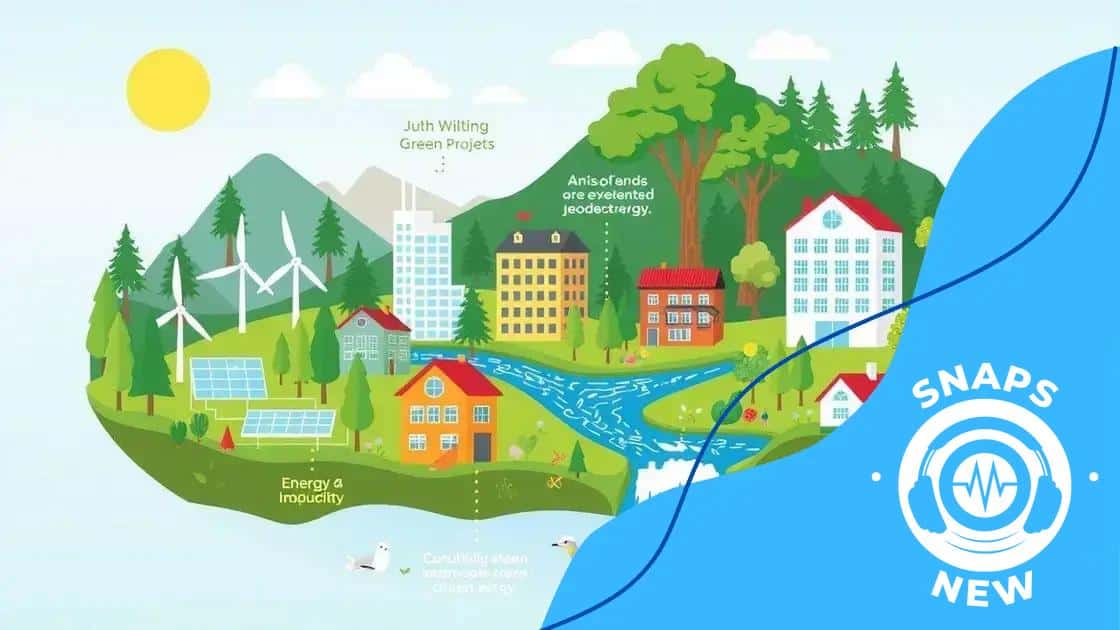Green bonds market expansion: unlocking investment opportunities

The green bonds market is rapidly expanding due to increasing demand for sustainable investments, technological innovations enhancing transparency, and alignment with global environmental goals, despite challenges like greenwashing and liquidity concerns.
Green bonds market expansion is reshaping investment landscapes by promoting sustainability and capturing investors’ attention. You’re likely curious about how these opportunities can impact the future of finance and what it means for our planet.
Understanding green bonds
Understanding green bonds is crucial for investors looking to align their portfolios with sustainable practices. These financial instruments fund projects that have positive environmental impacts, making them a compelling option for those interested in responsible investing.
Green bonds can finance a variety of initiatives, from renewable energy to energy efficiency improvements. By investing in them, you are supporting projects that help combat climate change and promote sustainability.
What are Green Bonds?
Green bonds are similar to traditional bonds, but their proceeds are specifically allocated to projects that benefit the environment. These bonds are issued by governments, corporations, or financial institutions, and they often come with specific environmental criteria that projects must meet.
Benefits of Investing in Green Bonds
- Access to growing sustainable investment markets.
- Support for climate-friendly projects.
- Potential for attractive financial returns.
- Diversification of investment portfolios.
As investors become more aware of climate issues, the demand for green bonds is rising. This trend reflects a shift toward more sustainable financial practices, as individuals and institutions seek to make a positive impact.
Risks Associated with Green Bonds
Like any investment, green bonds come with risks. Some of the challenges include:
- Greenwashing: misleading claims about environmental benefits.
- Market fluctuations impacting bond prices.
- Regulatory changes affecting project funding.
Understanding these risks is essential for making informed investment decisions in green bonds. They can provide both environmental benefits and financial returns, but it’s important to conduct thorough research.
Investors should always consider their risk tolerance and investment goals when placing their funds in any asset class, including green bonds.
Key drivers of market expansion
Several factors are driving the market expansion of green bonds, making them an increasingly attractive investment option. Understanding these key drivers can help investors navigate the evolving landscape of sustainable finance.
One major factor is the growing awareness of climate change and its impacts on the planet. More people and institutions are recognizing the importance of financing projects that contribute to sustainability. This shift in mindset creates a stronger demand for green bonds.
Government Support and Regulation
Government initiatives around the world are also significant drivers. Many countries are implementing policies to promote green finance.
- Subsidies and tax incentives for green projects.
- Regulations mandating sustainable practices.
- Public investment in renewable energy and infrastructure.
These policies encourage the issuance of green bonds, as they provide financial backing and legitimization for green projects.
Institutional Investor Demand
Another key driver is the growing interest from institutional investors. Many large funds and pension plans are shifting towards environmentally responsible investments. They seek to align their portfolios with the principles of sustainability, which increases the demand for green bonds.
The pressure from stakeholders, including consumers and shareholders, is intense. Investment firms are being urged to integrate sustainability into their decision-making processes, reinforcing the trend towards green finance.
Additionally, the increasing number of environmental, social, and governance (ESG) frameworks supports this growth. ESG criteria encourage companies to abide by sustainable practices, making green bonds an integral part of their financing strategy. This creates a favorable environment for market expansion.
Impact of green bonds on the environment

The impact of green bonds on the environment is a crucial topic for both investors and consumers. These financial instruments are designed to fund projects that improve environmental health and promote sustainability. With the right investments, green bonds can lead to significant positive changes in various sectors.
One major area of impact is renewable energy. Green bonds help finance wind farms, solar energy projects, and hydroelectric plants. By supporting these initiatives, we can reduce our reliance on fossil fuels, leading to lower greenhouse gas emissions.
Energy Efficiency Improvements
Another significant impact comes from investments in energy efficiency. Projects funded by green bonds often involve upgrading buildings and infrastructure to reduce energy consumption.
- Improving insulation in homes and offices.
- Installing energy-efficient lighting systems.
- Retrofitting outdated machinery in factories.
These actions not only lower energy bills for consumers but also help diminish the overall carbon footprint of communities.
Conservation and Biodiversity
Green bonds also support conservation efforts. They can fund projects aimed at protecting endangered species, restoring natural habitats, and maintaining biodiversity. These efforts are essential for ensuring a balanced ecosystem, which ultimately benefits all life on Earth.
Moreover, the funds may go towards sustainable agricultural practices that protect the soil and water while promoting biodiversity. By investing in environmentally friendly techniques, we can create a healthier planet for future generations.
As the demand for green bonds increases, the potential for a greener future becomes more achievable. The ripple effects of these investments extend to urban development, clean transportation, and pollution reduction, proving that financial support can lead to significant environmental benefits.
Challenges faced by investors
Investing in green bonds presents unique opportunities, but it also comes with several challenges that potential investors should be aware of. Navigating these challenges is key to successful investment in the green bonds market.
One primary challenge is the issue of greenwashing. This occurs when a bond is marketed as green or sustainable without meeting the necessary standards or criteria. It can be difficult for investors to identify genuine green bonds, leading to possible misallocation of funds.
Market Volatility
Market volatility is another concern for investors. Like all investments, green bonds are subject to economic fluctuations. Changes in interest rates or economic downturns can affect bond prices.
- Increased interest rates can lead to lower bond prices.
- Market instability may deter new issuances.
- Investor sentiment can fluctuate rapidly due to external factors.
Understanding these dynamics is essential for making informed decisions.
Limited Liquidity
Another challenge that investors face is limited liquidity. Green bonds may not be as liquid as traditional bonds, meaning they can be harder to buy and sell in the market.
Investors may find fewer buyers and sellers, which can result in wider bid-ask spreads. This situation makes it crucial for potential investors to assess their investment horizon and risk tolerance before committing to green bonds.
As the market grows and more players enter the scene, these challenges may evolve. Staying informed about industry developments can help investors navigate the complexities of green bonds.
Future trends in green financing
The future trends in green financing indicate a rapidly evolving market that reflects growing interest in sustainability. As more investors and corporations seek to align their financial activities with environmental goals, green financing provides exciting opportunities.
One significant trend is the increase in standardization and transparency in green bonds. More organizations are developing frameworks to define what makes a bond “green.” This effort helps investors evaluate and compare green bonds more effectively, reducing confusion in the market.
Technological Innovations
Technology will play a crucial role in shaping the future of green financing. Innovations such as blockchain can increase transparency and streamline the issuance of green bonds. This technology ensures that funds are used for their intended purpose, enhancing the credibility of projects.
- Blockchain for tracking fund allocation.
- AI for analyzing environmental impacts.
- Data analytics for investor insights.
These advancements are expected to attract more investors to green bonds, as technology can mitigate risks and increase confidence in their sustainability claims.
Focus on Sustainable Development Goals (SDGs)
Another trend is the alignment of green financing with the United Nations’ Sustainable Development Goals. Investors are becoming more interested in funding projects that directly contribute to these global objectives. This alignment encourages the funding of projects that not only promote environmental benefits but also address broader social issues.
As a result, green bonds may focus more on projects that provide social returns, such as affordable housing and access to clean water. This trend showcases the interconnectedness of environmental and social sustainability.
Looking ahead, the green financing landscape is poised for growth driven by increased demand for sustainability. As more players enter the market, innovations and frameworks will likely emerge to support both investors and projects. Keeping abreast of these trends will be vital for anyone involved in green financing.
In conclusion, the green bonds market is an exciting and rapidly evolving field. With increasing awareness of environmental issues and the demand for sustainable investment options, green bonds offer unique opportunities for investors, communities, and the planet. However, it is essential to stay informed about the challenges and trends that influence this market. As technology advances and frameworks become clearer, the potential for positive environmental impact through green financing will only grow. By navigating these dynamics carefully, investors can contribute to a greener future while pursuing their financial goals.
FAQ – Frequently Asked Questions about Green Bonds
What are green bonds?
Green bonds are financial instruments specifically used to raise funds for projects with positive environmental impacts, such as renewable energy or conservation.
What challenges do investors face with green bonds?
Investors may encounter challenges such as greenwashing, market volatility, and limited liquidity, making it essential to conduct thorough research.
How can technology improve green financing?
Technological advancements, like blockchain and AI, can enhance transparency, track funds, and streamline the issuance process in green financing.
How do green bonds align with global sustainability goals?
Green bonds support projects that contribute to the United Nations’ Sustainable Development Goals, focusing on environmental and social benefits.





